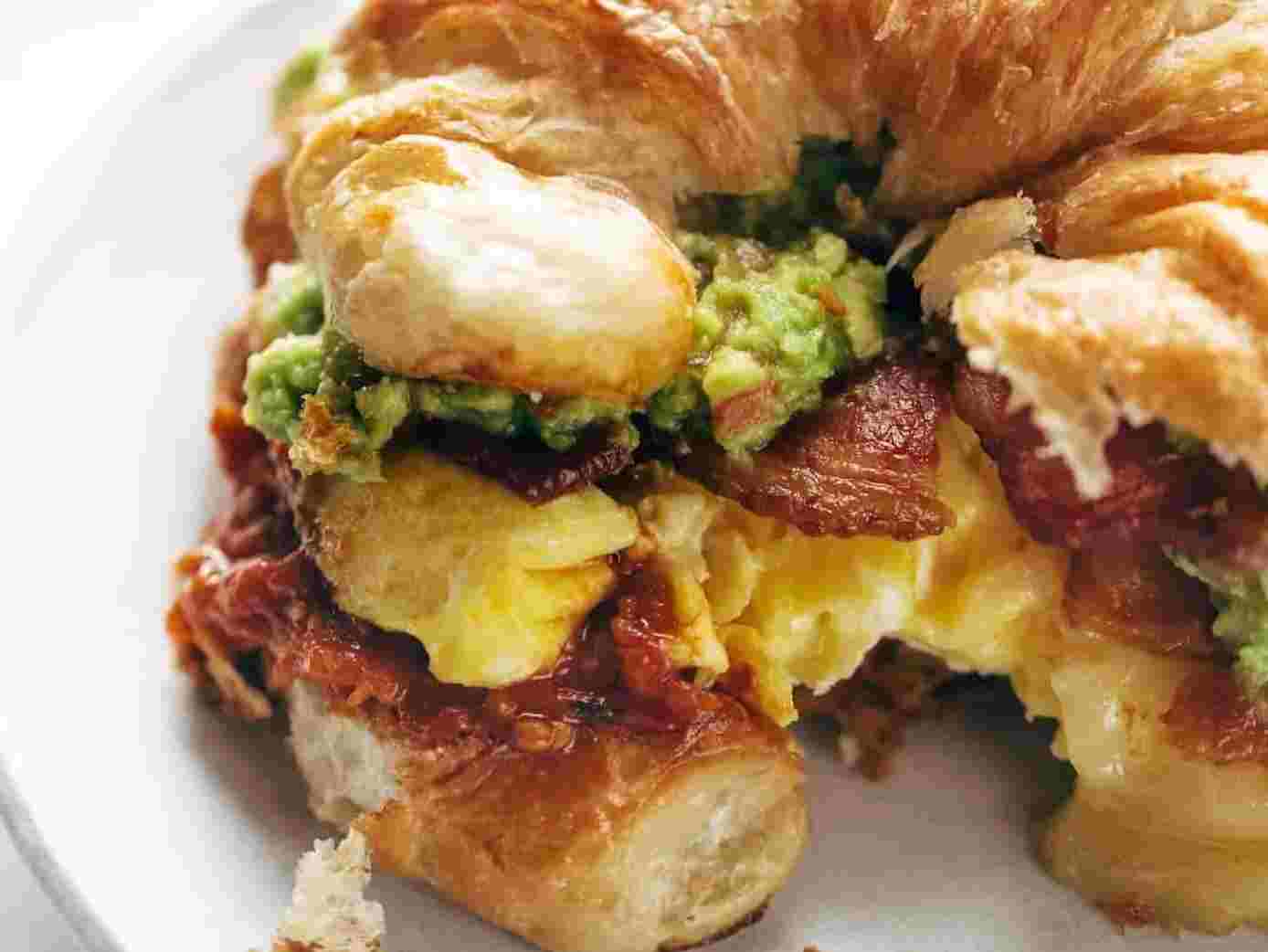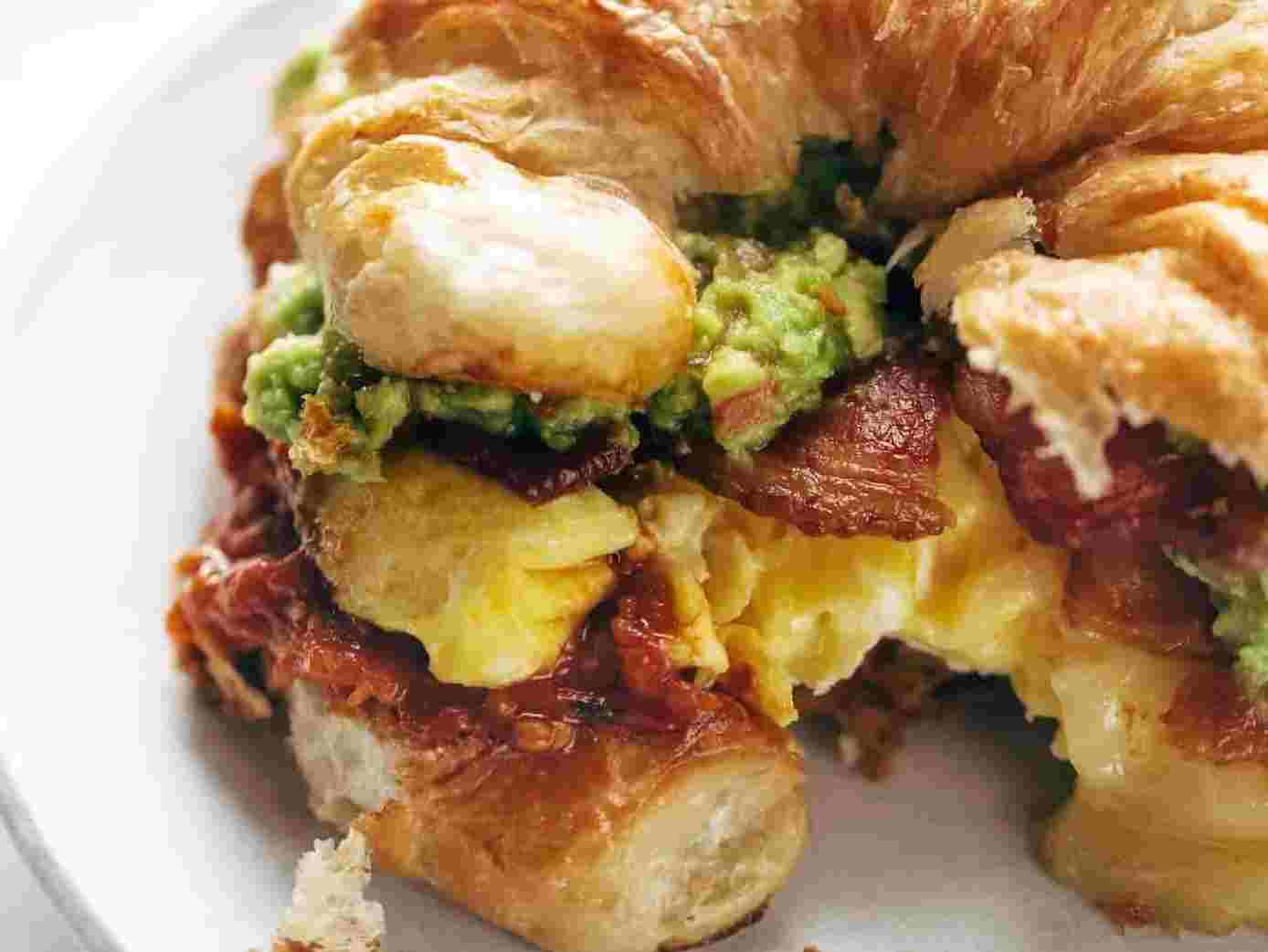Ultimate Breakfast Sandwich
Ultimate Breakfast Sandwich
The Ultimate Breakfast Sandwich with eggs, bacon, guacamole, chunky tomato sauce, cheese, all over toasted croissant. Totally over the top.
Ready in: 15 minutes
Serves: 4
Complexity: very-easy
kcal: 587
Share

Ingredients
8 eggs
4 slices cooked bacon
4 croissants or cheese muffins
Guacamole
Cheese
Garlic butter
¼ tsp SIDS CRAZY SALT
Tuimato sauce
Directions
Toast the croissants for a few minutes in a 175°C oven, cut side down on an oven tray. You can also do this in the toaster if your croissants fit.
When croissants are toasted and all other ingredients are out and ready, cook up the eggs. SOFT SCRAMBLED, remember?
Assemble sandwiches immediately, while eggs are at their best – a layer of Tuimato sauce, eggs, cheese, bacon, guacamole and sprinkle SIDS CRAZY SALT on top.
History:- A croissant is a buttery, flaky, viennoiserie pastry of Austrian origin, but mostly associated with France. Croissants are named for its historical crescent shape and, like other viennoiserie, are made of a layered yeast-leavened dough. The dough is layered with butter, rolled and folded several times in succession, then rolled into a thin sheet, in a technique called laminating. The process results in a layered, flaky texture, similar to a puff pastry.
Crescent-shaped breads have been made since the Renaissance, and crescent-shaped cakes possibly since antiquity. Croissants have long been a staple of Austrian, Italian, and French bakeries and patisseries. The modern croissant was developed in the early 20th century. In the late 1970s, the development of factory-made, frozen, pre-formed but unbaked dough made them into a fast food that can be freshly baked by unskilled labour. The croissant bakery, notably the La Croissanterie chain, was a French response to American-style fast food, and as of 2008, 30–40% of the croissants sold in French bakeries and patisseries were baked from frozen dough. Croissants are a common part of a continental breakfast in many European countries.
The kipferl, the origin of croissant, can be dated back to at least the 13th century in Austria, and came in various shapes. The kipferl can be made plain or with nuts or other fillings. (some consider the rugelach a form of kipferl)
The birth of the croissant itself—that is, its adaptation from the plainer form of kipferl, before the invention of viennoiserie—can be dated to at least 1839 when an Austrian artillery officer, August Zang, founded a Viennese bakery ("Boulangerie Viennoise") at 92, rue de Richelieu in Paris. This bakery, which served Viennese specialties including the kipferl and the Vienna loaf, quickly became popular and inspired French imitators. The French version of the kipferl was named for its crescent (croissant) shape and has become a universally identifiable shape across the world.
By 1869, the croissant was well established enough to be mentioned as a breakfast staple, and in 1872, Charles Dickens wrote (in his periodical All the Year Round) of "the workman's pain de ménage and the soldier's pain de munition, to the dainty croissant on the boudoir table."
The puff pastry technique which now characterizes the croissant was already mentioned in the late 17th century, when La Varenne's Le Cuisinier françois gave a recipe for it in the 1680 and possibly earlier, editions. It was typically used not on its own but for shells holding other ingredients (as in a vol-au-vent). It does not appear to be mentioned in relation to the croissant until the 20th century.
The legends include tales that it was invented in Europe to celebrate the defeat of the Umayyad forces by the Franks at the Battle of Tours in 732, with the shape representing the Islamic crescent; that it was invented in Buda; or, according to other sources, in Vienna in 1683 to celebrate the defeat of the Ottomans by Christian forces in the siege of the city, as a reference to the crescents on the Ottoman flags, when bakers staying up all night heard the tunnelling operation and gave the alarm.
According to one of a group of similar legends, which vary only in detail, a baker of the 17th century, working through the night at a time when his city (either Vienna in 1683 or Budapest in 1686) was under siege by the Turks, heard faint underground rumbling sounds which, on investigation, proved to be caused by a Turkish attempt to invade the city by tunnelling under the walls. The tunnel was blown up. The baker asked no reward other than the exclusive right to bake crescent-shaped pastries commemorating the incident, the crescent being the symbol of Islam. He was duly rewarded in this way, and the croissant was born. The story seems to owe its origin, or at least its wide diffusion, to Alfred Gottschalk, who wrote about the croissant for the first edition [1938] of the Larousse Gastronomique and there gave the legend in the Turkish attack on Budapest in 1686 version; but on the history of food, opted for the 'siege of Vienna in 1683' version.
This has led to croissants being banned by some Islamic fundamentalists.

